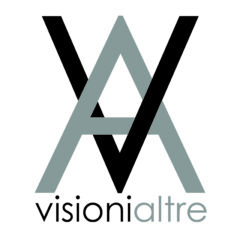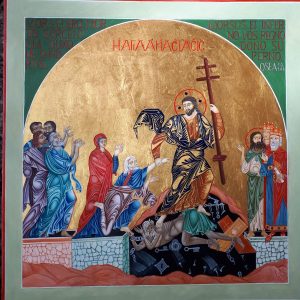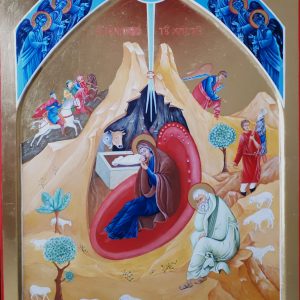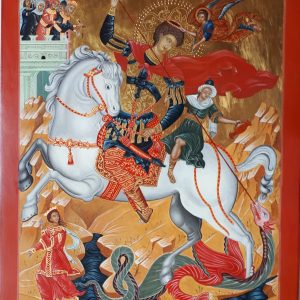“Per incontrare la bellezza a volto svelato,
per attingere alla ricchezza della sua grazia,
occorre mediante una trans-ascendenza,
mediante un superamento del sensibile e dell’intelligibile oltrepassare
le porte del Tempio ed è l’icona.”
(Pavel Nikolaevič Evdokimov)
Con ‘’ICONE ‘’ l’artista propone una serie di copie di dipinti di una antica arte bizantina eseguite seguendo fedelmente regole rigorosissime.
Il centro principale dello sviluppo di questa antica arte bizantina era Costantinopoli, e con il trascorrere del tempo, la varietà di stili e di tipologie artistiche si ampliarono in Russia, e nel resto del mondo ortodosso.
Le opere ci rimandano a questo particolare mondo bizantino con tavolette dipinte seguendo il dettame delle Icône antiche sia nell’uso dei supporti che nei cromatismi in particolare nell’uso della doratura elemento importante per la rappresentazione delle immagini sacre.
Le opere sono realizzate su tavole di legno di varie dimensioni. Sulla superficie viene stesa la colla sulla tela, del gesso e segue la levigatura, si procede quindi al disegno, seguono i colori, prima i più scuri per poi passare ai chiari e alla doratura, caratteristica delle rappresentazioni ultraterrene. I colori usati hanno una loro rispondenza a vari significati, Il blu, ad esempio, rappresenta il colore della trascendenza, mistero della vita divina, Il bianco è il colore dell’armonia, della pace, di Dio, che rappresenta la luce, Il rosso è simbolo dell’umano e del sangue dei martiri; Il verde è il simbolo della natura, della fertilità e dell’abbondanza; Il marrone, simboleggia la terra, la povertà e l’umiltà. I dipinti rispecchiano la modularità tradizionale stilizzata delle antiche usanze stilistiche dell’iconografia come la bidimensionalità, la stilizzazione e le dimensioni solitamente piccole. Un’altra caratteristica delle ICONE e quella che non venivano firmate, solamente in alcuni casi quando la committenza era di un principe o di una autorità ecclesiastica.
Ma chi sono le ICONE in epoca moderna? Non possiamo non citare Malevich con il suo quadrato nero su fondo bianco che ha cambiato radicalmente il pensiero religioso nell’esprimere il temine “ICONA”. Negli anni 60’ un altro grande artista americano Andy Warhol ha radicalmente cambiato il concetto di arte il quale sottolinea che le sue ICONE venerate (Marilyn Monroe ) si ispirano al concetto delle ICONE russe riproponendo la riproducibilità e il multiplo sfruttando così la tecnologia di una società industriale.
Clizia Brino : Mi avvicinai sull’icona sacra tramite l’osservazione e lo studio di opere di alcuni maestri iconografi: ne apprezzai il valore spirituale, la bellezza artistica e il linguaggio ricco di simboli; tutto ciò mi fu di stimolo per approfondire, con l’impegno concreto, la conoscenza di questa particolare forma espressiva.
Iniziai sedici anni or sono con la partecipazione ad alcuni corsi pratici, tenuti a Venezia dal maestro Giovanni Raffa. Nel corso del tempo esposi, qualche icona, in alcune mostre collettive.
With ‘’ICONE‘’ the five artists propose a series of paintings made with the ancient byzantin technique done following very rigorous rules.
The centre of the developement of this ancient byzantine technique was Constantinople, and with the passing of time, the variety of styles and artistic typologies expanded in Russia, and in the rest of the orthodox world.
The artists’ artworks refer to this peculiar byzantine world with painted tables following the ancient Icône both in the use of struts and the chromatisms, in particular in the use of gold leaf as an important element for the representation of sacred images.
In this iconographic journey among the various works present I think it is only right to pause and reflect on a copy of a work by Rublëv Andrej ” the Trinity ” Icon where the episode taken from the Old Testament about the visit to Abraham by the three messenger angels is treated. The “historiated tablet'” is an image that has the power to represent the true meaning of the “Trinity ” as one of the most beautiful and meaningful that exist in the icône world. The scene unfolds with just a few figures at the place of sacrifice. A Eucharistic chalice holds the head of the lamb, and the three perfectly distinct figures, from the background elements to the folds of the garments and to their own geometries envelop the infinity that embraces them. On the left is the angel representing the Father and in the middle of the trinity sits the Son, on the right the Spirit. Son and Spirit make clear the identity of the Father by bending their heads toward Him. The gesture of the Son and the Spirit is accompanied by that of the tree and the rock. The figure of the son in the center determines the true fruit of the Tree of Life since he is the life. The rock is the place where God communicates. Note also the pastoral staffs that the three figures bear in the left go gradually approaching the verticality of that of the Father. On the white altar cloth the dance of hands silently explains the meaning of the sacred conversation. The gaze and gestures of the figures tell with the essential evidence of symbol the drama that invests their lives. The distinction of the figures, in the inseparability of their light and drama, is accomplished in the chromatic timbres proper to each. Also of gold is the house behind the Father. The figure of the Spirit has a blue robe like the mantle of the son, all in the unity of the circle of the composition including the golden wings of the three components. The author of this important tablet is Andrej Rublëv (1360 – Moscow 1430 ) of Polish origin Russian painter, considered the greatest icon painter. He is venerated as a saint by the Orthodox Church. Known for his production of ICONS and frescoes in Orthodox churches in Russia and in miniatures in the VANGEL OF CHITROVO. Worth mentioning is the 1966 film directed by director Andrei Tarkovsky inspired by the painter’s life.
The works created by the five artists, are made on wooden boards of various sizes. On the surface, glue is spread on the canvas, some gesso and sanding follows, then the drawing is done, followed by the colors, first the darker ones and then the light ones and the gilding, characteristic of the otherworldly representations. The colors used have their own correspondence to various meanings, Blue, for example, represents the color of transcendence, mystery of divine life, White is the color of harmony, peace, God, representing light, Red is symbolic of the human and the blood of martyrs; Green is symbolic of nature, fertility and abundance; Brown, symbolizes the earth, poverty and humility. The paintings reflect the traditional stylized modularity of ancient stylistic customs of iconography such as two-dimensionality, stylization and usually small size. Another characteristic of the ICONS is that they were not signed, only in some cases when the commission was from a prince or ecclesiastical authority.
But who are the ICONS in modern times? We cannot fail to mention Malevich with his black square on a white background who radically changed religious thinking in expressing the term “ICON.” In the 1960s’ another great American artist Andy Warhol radically changed the concept of art who points out that his revered ICONS (Marilyn Monroe) are inspired by the concept of Russian ICONS by reproducing reproducibility and the multiple thus exploiting the technology of an industrial society.
Clizia Brino : I approached on the sacred icon through the observation and study of works of some iconographic masters: I appreciated its spiritual value, artistic beauty and language rich in symbols; all this was a stimulus for me to deepen, with concrete commitment, the knowledge of this particular form of expression.I began sixteen years ago with the participation in some practical courses, held in Venice by master Giovanni Raffa. In the course of time I exhibited, a few icons, in some group exhibitions.




